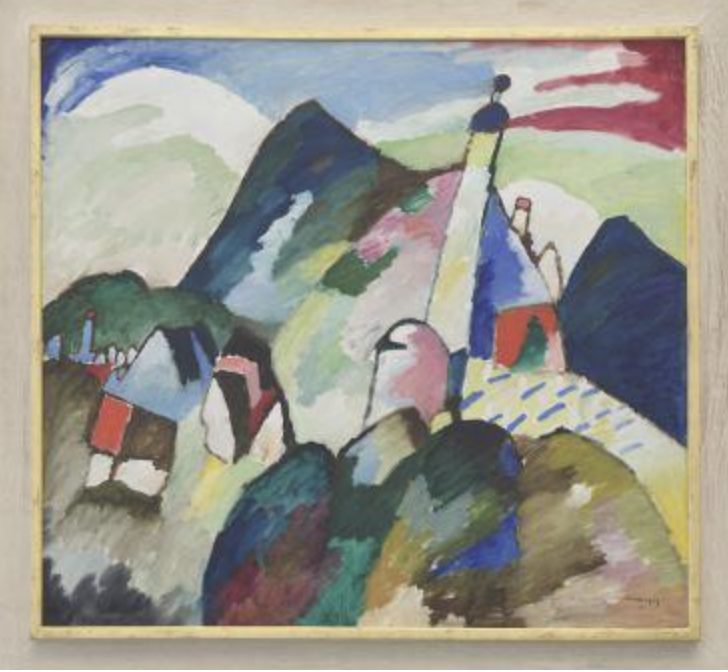Dutch Museum Returns Kandinsky Painting to Heirs of Jewish Collector

The Committee has assessed an application dated 25 February 2019 for restitution of the painting Blick auf Murnau mit Kirche [known in English as View of Murnau with Church] by the artist Wassily Kandinsky
The Committee has assessed an application dated 25 February 2019 for restitution of the painting Blick auf Murnau mit Kirche [known in English as View of Murnau with Church] by the artist Wassily Kandinsky. Eindhoven City Council became owner of the work in 1951, and it has hung in the Van Abbemuseum in Eindhoven since then. The Committee issued a binding opinion on 29 January 2018 rejecting an earlier application for restitution of this work because it was not possible to establish with the required degree of plausibility that Johanna Margarethe Stern-Lippmann (1874-1944), the Applicants’ Jewish grandmother/great-grandmother, had lost possession of the work during the Nazi regime.
The request for reconsideration by the City Council and the Applicants was submitted on the grounds of new facts that apparently had emerged from correspondence and lists of artworks that were not previously known to the Committee. The Committee has established that these documents do indeed contain new facts.
Those new facts and the investigation that was launched on the basis of them have given the Committee reason to conclude that it is now sufficiently plausible that the painting ceased to be in the possession of Margarethe Stern-Lippmann during the Nazi regime.
The Committee’s changed conclusion is based on the following three considerations. In accordance with the requirement in the Washington Principles, during the assessment the Committee took into account ‘unavoidable gaps or ambiguities in the provenance in light of the passage of time and the circumstances of the Holocaust era’.
- The art dealer Karl Legat sold the work to the City Council in 1951. The Van Abbemuseum’s inventory card contains the following provenance information: ‘vroeger verz. Kaufmann; door diens in Nederl. wonende dochter verkocht Légat. (Opg. Légat)’. [‘previously the collection of A. Kaufmann; whose daughter living in the Netherlands sold it to Légat. (Stated by Légat)’.] It has become plausible that ‘A. Kaufmann’ alludes to the artist Arthur Kaufmann (1888-1971). On the grounds of the new research, however, it is improbable that Legat purchased the work from him or his daughter, and it is extremely unlikely that Kaufmann ever possessed the work. The purchase price that Legat allegedly paid to Kaufmann’s daughter furthermore indicates that Legat did not acquire the work until after the war, while the Kaufmann family left the Netherlands before the occupation. The City Council has stated that it does not doubt that the work was purchased in good faith, but it does not wish to invoke good faith.
- It emerges from the documents newly submitted by the Applicants that until 1952 the Applicants’ family assumed that the Kandinsky was still in her possession. It was not until a valuer investigated which artworks were still actually present in June 1952 that it emerged that the Kandinsky was no longer in the family’s possession. On the grounds of the available information, the Committee considers it unlikely that the work ceased to be in the family’s possession after the occupation.
- The newly unearthed documents include a picture postcard of Blick auf Murnau mit Kirche by Kandinsky that art dealer Myrtil Frank’s wife sent to a third party in 1966. On the picture postcard she wrote: ‘This was our Kandinsky’. That message and the fact that during the war her husband was involved in transactions, or attempted transactions, relating to obtaining works owned by the Applicants’ grandmother/great-grandmother make it plausible that she and Myrtil Frank got their hands on Blick auf Murnau mit Kirche at some point.
Viewing 1, 2 and 3 together, the Committee concludes that it is plausible that the work did not leave the possession of Margarethe Stern-Lippmann before the occupation, that the family did not sell it after the occupation, that Margarethe lost possession of it during the occupation, and that it came into the possession of the Franks. Margarethe’s loss of possession took place during the occupation and she was a private individual who, because of her Jewish descent, belonged to a persecuted population group. On the grounds of criterion 3.1 of the assessment framework, the Committee therefore assumes that her loss of possession was involuntary. The Committee therefore rules that the Kandinsky painting should be returned to the heirs of the original owner.
